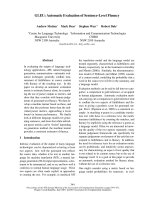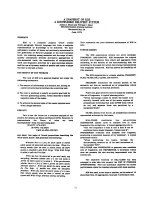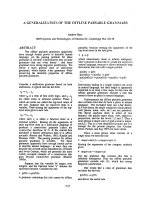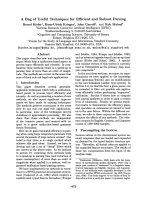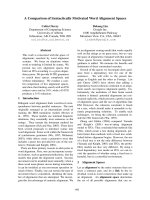Báo cáo khoa học: "A MODEL OF SENTENCE PRODUCTION" pdf
Bạn đang xem bản rút gọn của tài liệu. Xem và tải ngay bản đầy đủ của tài liệu tại đây (433.81 KB, 5 trang )
G~4S: A MODEL OF SENTENCE PRODUCTION
Domenico Parisi Alessandra Giorgi
Istituto di Psicologia del C.N.R.
Reparto Processi Cognitivi e Intelligenza Artificiale
Via dei Monti Tiburtini, 509
00157 Roma, Italy
ABSTRACT
The paper describes GEMS, a system for
Generating and Expressing the Meaning of
Sentences, focussing on the generation task,
i.e. how GEMS extracts a set of propositional
units from a knowledge store that can be
expressed with a well-formed sentence in a
target language. GEMS is lexically
distributed. After a central processor has
selected the first unit(s) from the knowledge
store and activated the corresponding lexical
entry, the further construction of the
sentences meaning is entrusted to the entries
in the vocabulary. Examples of how GEMS
constructs the meaning of a number of English
sentence types are briefly described.
I.
Constructing the meaning of
sentences
Most work on natural language generation
has been concerned with the production of
connected text (Davey, 1979; Goldman, 1975;
Mann and Moore, 1981; Meehan, 1977) or with
language generation as a goal-directed,
planned activity (Appelt, 1980; Mann
and
Moore, 1981). Less attention has been
dedicated to the linguistic details of
sentence generation, i.e. to constructing a
general device for imposing the appropriate
linguistic form to the content that must be
expressed (but see Kempen and Hoenkamp,
1982).
The aim of this paper is to describe GEMS,
a system for Generating and Expressing the
Meaning of Sentences. GEMS takes a store of
knowledge as input and gives English sentences
expressing that knowledge as output. The
knowledge contained in the knowledge store is
purely conceptual knowledge with no trace of
linguistic form. There is no partitioning of
knowledge in parts which can be expressed by
single sentences or by single lexical items,
no grammatical labelling of items as verbs,
nouns, or subjects, objects, etc., no other
traces of syntactic or lexical form. Hence, a
first task of GEMS is to extract from the
knowledge store the knowledge which it is
appropriate to express in a well-formed
sentence, i.e. to generate the meaning of the
sentence. Since the meaning thus constructed
must be expressed with a specific sequence of
words, two further tasks of GEMS are to
select the semantic and grammatical morphemes
that make up the sentence and to put them in
the appropriate sequential order.
Producing sentences is a goal-directed
activity: what one says depends on one's
goals. GEMS however is a model of how to say
something, not of what to say. When it
arrives at a decision point on what to say,
GEMS makes a random choice. Hence, GEMS is
not a complete model of the activity of
producing sentences but only a model of the
linguistic constraints on the communication
of knowledge
and
ideas.
GEMS conceives the knowledge necessary to
produce sentences as largely distributed in
the lexicon. This change from previous more
centralized version of GEMS (see Parisi and
Giorgi, 1981; 1983) has been suggested to us
by Oliviero Stock and Cristiano Castelfranchi
and it is related to our view of a lexically
distributed sentence comprehension process
(see Stock, Castelfranchi, and Parisi, 1983;
Parisi, Castelfranchi, and Stock, in
preparation). The lexical entries are
procedures that activate each other in a
given order when a sentence is produced,
although the order of activation may not
coincide with the external sequential order
of the words in the actual sentence. When
executed the entries' procedures (a) extract
the sentence's meaning from the knowledge
store, (b) lexicalize this meaning with the
appropriate semantic and grammatical
morphemes, and (c) put these morphemes in the
correct sequential order. A central processor
has the task of searching the knowledge store
for knowledge to be expressed and the lexicon
for the lexical entries that can express this
knowledge. However, the main task of the
central processor is to start the
construction process and to keep a record of
the order of activation of the lexical
entries. The overall scheme of GEMS is
represented in Fig. 1
258
KNOWLEDGE
STORE
/
I LEXICON
C•E•RAL
I
I
J ~ SENTENCE I
Fig. 1. Overall scheme of GEMS
In the present paper our purpose is to
describe GEMS with respect to its first task,
i.e. how GEMS generates the meanings of
sentences by extracting syntactically
appropriate knowledge from the knowledge
store. We will proceed by first describing
the knowledge store, the vocabulary, and the
central processor, and then briefly analyzing
some sentence types to show how GEMS
constructs their meanings.
2.
The
knowledge
store
The world knowledge of the system, or as
we will say, its encyclopedia (ENC), is
represented as a set of propositional units.
A propositional unit is made up of a
predicate, the predicate's arguments, and a
label that uniquely identifies each unit.
Argument and labels have number codes that
indicate when they refer to the same entity
(same code) or to different entities
(different codes). Labels are represented as
Cs whereas arguments can be either Xs or Cs.
When an argument of a unit is a C, this means
that the unit is a "recursive" one, i.e. a
unit which takes another unit as its
argument. In such case the C argument is the
label of the unit taken as an argument.
Let us assume that the system has the
knowledge items represented in (I), i.e. (I)
is the system's ENC. Obviously, neither the
absolute numbers assigned to the arguments
and labels nor the order of listing of the
units in (I) have any meaning.
(I) CI:
Xl
BILL C6: Xl THINK C7
C2: XI SEE X2 C7:X2 LEAVE
C3:X2
MARY C8:X4 DOG
C4:X3 ARRIVE C9:X4
SLEEP
C5:X3 JOHN CI0:C9 DEEP
As (I) makes it clear, no traces of
lin~-uistic form are present in ENC. The
knowledge items in (I) are not marked as
being nouns, verbs, or any other grammatical
classes; furthermore, nothing is subject,
object, attribute, or any other functional
class. Finally, there is no indication in (I)
of which items make up a well-formed sentence
or other syntactic phrases.
3- The lexicon
In order to extract a syntactically well-
formed meaning from ENC and express it with
the appropriate sequence of semantic and
grammatical morphemes the system utilizes a
vocabulary (VOC). VOC is a set of
meaning/signal pairs called lexical entries.
GEMS' vocabulary is a morphological one, i.e.
the vocabulary includes lexical entries which
are "roots" (e.g. see-) and lexical entries
which are "(inflexional) suffixes" (e.g. -s).
However, for the purpose of describing the
sentence meaning construction process we can
assume a simplified vocabulary of whole
words.
The meaning of a lexical entry is made up
of four components.
(a)
There
are first of all one or more
propositional units with the same types of
predicates that are found in ENC. The only
difference is that the units which are found
in a lexical entry have letter codes and not
number codes on their arguments and labels.
(The number codes show the llnklngs among the
various units within ENC and, as we will see,
within a sentence's meaning. The letter codes
indicate the linkings among units within a
single lexical entry.) These propositional
units represent the semantic content of a
lexical entry. They are called semantic units
(SU). Even though the SUs of an entry may be
more than one, we will represent the semantic
content of the entries with a single SU, i.e.
without lexical decomposition.
(b) Secondly, the meaning of a lexical entry
contains a list of one or more "saturation
instructions" on the arguments of the SUs.
These saturation instructions correspond to
the assembly instructions that play a central
role in the sentence comprehension process
(see Stock, Castelfranchi, and Parisi, 1983),
where they serve to assemble together in the
appropriate way the separate meanings of the
words making up the sentence to be
understood. A saturation instruction is "on"
a given argument of the SUs of the lexical
entry. For example, a verb like to take has a
SU "CA:
XA TAKE XB" and two saturation
instructions on XA and XB, respectively. A
noun like president has a SU "CA: XA
PRESIDENT XB" and a saturation instruction on
XB. A saturation instruction on a given
argument is a procedure for (i) extracting
from the knowledge store a propositional unit
having the argument to be saturated as its
argument or its label, and (ii) identifying a
lexical entry in VOC which has the extracted
259
propositional unit among its SUs.
(c) A third component of a lexical entry is a
"marker". Lexlcal entries contain one of
three types of markers: TEMP, HEAD, and ADV.
TEMF is a marker of verbs (full verbs not
copula or auxiliary verbs), adjectives and
some uses of "semantic" prepositions (as in
The book is for. Susan, The bottle is on the
table). HEAD is a marker of nouns (including
nominalizations llke arrival). ADV is a
marker of adverbs, subordinating
conjunctions, and some other uses of
"semantic" prepositions (as in Bill is eatin~
in the kitchen). Markers are procedures for
selecting the next step to be taken by the
meaning construction process when the
saturation instructions of a lexical entries
have all been executed. As procedures markers
make reference to the record of the order of
activation of the lexical entries which is
kept by the central processor. Therefore, we
will explain the meaning of TEMP, HEAD, and
ADV after describing the central processor.
(d) Finally, lexical entries include as a
fourth component one or more additional
propositional units having special predicates
which are different from the semantic
predicates of the units in ENC and the SUs in
the vocabulary entries. These special units
control the lexlcallzation of the grammatical
morphemes and therefore they won't be
mentioned in this paper.
4. The central processor
The central processor executes the
procedures of the lexical entries, both the
saturation instructions and the markers.
However in addition it has two specific tasks
of its own which represent the non-lexically
distributed portion of GEMS.
First of all, the central processor starts
the whole process by selecting in ENC a unit
having a specified argument as one of its
arguments or as its label, and then looking
up in VOC a lexical entry that can lexicalize
this unit, i.e. that has this unit as the
lexical entry's SU. This is the first step of
the sentence production process and it is the
central processor which is responsible for
it.
Secondly, the central processor keeps a
record of the order of activation in VOC of
the lexical entries that will make up the
sentence (more precisely, the sentence's
"content words"). The meaning of the sentence
to be produced is constructed step by step by
activating and executing the meanings of
these lexical entries. In order to control
this process GEMS must rely on a trace of the
path traversed by the lexical activation
process. More specifically, for each lexical
entry which is activated there is a record of
the lexical entry that activated the entry.
This allows the system at any time to "step
back", i.e. to trace back from an active
lexical entry to the lexical entry that
activated it. The latter entry becomes the
new active lexical entry.
We can now return to the markers contained
in the lexical entries and explain the
meaning of HEAD, TEMP, and ADV. As already
noted, these are names of procedures that are
executed after all the unsaturated arguments
of the lexical entry have been saturated.
HEAD is a very simple instruction to step
back to the lexical entry from which the
system originally moved to the currently
active lexical entry (ALE), and to make this
entry the new ALE. As we know HEAD is carried
by nouns and therefore it is an instruction
to move from the current noun to the
governing verb (Bill sleeps), noun (the
president of the Company) or adverbial
preposition (in the ~arden).
TEMP is a two step procedure. The first
step is a recursive instruction to search ENC
for a unit which has the label of the current
ALE as one of its argument
and
then
lexicalize this unit. Since TEMP is carried
by verbs and adjectives, it is an instruction
for constructing one or more adverbials
modifying the verb or adjective (Bill sleeps
deeply, Mary is very nice, Bill sleeps deepl 7
in the bed). When this first step has been
executed TEMP has a second instruction to
step back. This allows the system to step
back from a subordinate clause verb to the
governing verb, noun or adverbial conjunction
(Bill thinks that Mary left, The announcement
that Bill had won delighted Peter, When Bill
went to New York Mary was relieved). If there
are no entries to step back to, the
construction process ends.
ADV is very similar to TEMP. It first
attempts to construct recursive adverbials in
ENC (adverbials modifying adverbials, e.g.
Bill sleeps very deeply) and then it steps
back, ultimately to the verb or adjective
being modified.
Before proceeding to analyze how GEMS
constructs the meaning of various English
sentence types it is necessary to note two
limitations of the system as it is now.
A first limitation is that the procedure
produces sentences only in response to a
question to say something on a specific
entity that is pointed out to the system from
outside. An example could be "Say something
on Napoleon". The system's response would be
to produce a sentence expressing some
260
knowledge it has about Napoleon. A second
limitation is that GEMS does not produce
sentences containing pronouns and sentences
where the starting entity is not included in
the sentence's main clause. An extension of
GEMS to sentences containing pronouns is
described in Giorgi and Parisi (1984). As for
sentences with the starting entity outside
their main clauses they raise problems
related to the status of the propositional
units in ENC, i.e. whether a particular unit
is "believed" by the system or not (for a
treatment within the present framework, see
Castelfranchi, Parisi and Stock, 1984). If
the starting entity is "Mary" and the system
knows that Bill thinks that Mary left it
would not be appropriate for the system to
produce a statement like Mary left. However,
we won't deal with these problems in the
present paper.
5.
How the
meaning of various
sentence types
is constructed
Consider how the meaning of a simple
sentence llke Bill saw Mary isconstructed by
GEMS.
Let us assume that the system is asked to
produce a sentence about Mary, or more
precisely about argument X2 (see the
encyclopedia in (I)). The central processor
searches ENC for a unit having X2 as its
argument or label. The unit "C2: XI SEE X2"
is selected. The central processor looks up
in VOC a lexical entry having a corresponding
unit among its SUs. Assume that VOC contains
lexical entry (2).
(2) Semantic Marker Saturation
Units Instruct.
CA: XA SEE XB TEMP(CA) XA,XB saw 32
This entry is identified and it becomes the
"active lexlcal entry" (=ALE). Its
identification number, 32, is recorded by the
central processor along with the activating
agent. Since the activating agent in this
case is the central processor (CP) itself the
pair "CP, 32" is recorded.
How the meaning of the entry executes
itself. Since the entry contains two
saturation instructions they are executed in
whatever order. Assume that XA is tackled
first. The processor searches ENC for a unit
having XA, or more precisely its
corresponding argument in ENC, X1, as one of
its arguments or as its label. The unit "C1:
XI BILL" is selected. To lexlcalize this unit
the processor identifies lexical entry 14 in
VOC:
(3)
CA: XA BILL HEAD(XA) Bill 14
Entry 14 becomes the new ALE and the
processor record its identification number,
14, along with the identification number of
the activating entry: "32, 14".
The entry Bill has no saturation
instructions. Therefore, the processor
executes its marker: HEAD(XA). It steps back,
i.e. it makes the activating entry, 32, the
new ALE.
The new ALE, saw, has a further argument
to be saturated: XB(=X2). This leads to the
selection of unit "C3:X2 Mary" in ENC and to
the identification of the following entry in
VOC:
(4)
CA: XA MARY BEAD(XA) Mary 5
5 is the new ALE. The processor records "32,
5". Since Mary doesn't have saturation
instructions, BEAD directs the system to step
back to 32 again.
At this point there are no further
instructions of saw and the entry's marker,
TEMP(CA), can be executed. TEMP checks
whether there are in ENC propositional units
having CA(=C2) as their argument that the
system may want to express (as averbials).
Since the answer is No, TEMP directs the
system to step back. But there is no lexical
entry to step back to because saw is the
initial lexical entry, i.e. the entry
initially activated by the central processor.
Hence, the meaning construction process ends
here. The meaning of the sentence Bill saw
Mary has been constructed.
The mechanism of the saturation
instructions allows for an indefinite "going
down" of the construction process. A noun
phrase like the president of the company in
the sentence Bill saw the president of the
company is constructed by first selecting a
noun which has a saturation instruction
(president) and then a further noun to
saturate that instruction (company). When
company is reached, since this noun has no
saturation instructions, the system steps
back first to president and then to the
initial verb saw.
In a similar way the meaning of
nominalizations like John's arrival (see (I))
can be generated using the following lexical
entry for arrival:
(5)
CA: XA ARRIVE HEAD(CA) XA arrival 15
Subordinate clauses, i.e. verb-, noun-, and
adverbial-complements, can all be generated
by the same mechanism. The only difference is
261
that when their meaning has been completed
the TEMP marker of the subordinate clause
verb directs the system to step back to the
higher verb, noun or adverbial to continue
with the construction process at the higher
level.
Consider how the meaning of the sentence
Bill thinks that Mary left is constructed.
Let us assume that the system is asked to
produce a sentence about XI (Bill) and that
the unit which is selected in ENC is "C6: XI
THINK C7". This unit is lexicalized with the
following entry:
(6)
CA: XA THINK CB TEMP(CA) XA, CB thinks 81
If the argument CB (:C7) is first taken up
for saturation, this leads to the selection
of unit "C7: X2 LEAVE" in ENC and the
activation of the entry left in VOC. At this
point left is the new ALE. Its only argument
is saturated with Mary and then the system
steps back first to left and then to thinks.
Thinks has another argument to be saturated,
XA " : XI). The system saturates Xl with Bill.
Thus, the meaning of Bill thinks that Mar x
left has been completed.
Adverbials modifying verbs or adjectives
are also generated by TEMP. Consider the
sentence The dog sleeps deeply. When the
saturation instruction of sleeps has been
executed (thereby generating the meaning of
dog), the TEMP marker of sleeps searches ENC
for units having the TEMP-marked argument
(C9) as one of their arguments. The unit
"CIO: C9 DEEP" is found. This unit is
lexicalized with the entry:
(7)
CA: CB DEEP ADV(CB) deeply 36
Since deeply has no saturation instructions
and its marker ADV cannot find further
adverbials in ENC, the system steps back to
saw and the construction process ends. The
meaning of the sentence The do~ sleeps
deeply has been constructed.
GEMS can be slightly modified to generate
equative sentences (Fido is a do~) and
sentences containing noun modifiers (a nice
~irl, the ~Irl who was smilinG). Furthermore,
GEMS can also deal with cases where the
initial lexlcal entry activated by the
central processor is not a TEMP-marked entry,
as it was the case in the examples analyzed
above, but it is a HEAD- or an ADV-marked
entry, i.e. a noun or an adverb.
A version of GEMS for one-clause Italian
sentences has been implemented by G.Adorni in
FranzLisp on a VAX computer at the University
of Genova.
"REFERENCES"
Appelt, D.E. Problem solving applied to
language generation. Proceedings of the 18th
Annual Meetin G of ACL, 1980, pp.59-63.
Castelfranchi, C., Parisi, D., Stock, O.
Extending the expressive power of proposition
nodes. In B.G.Bara
and
G.Guida (eds.),
Computational ' Models of Natural Language
Processing. Amsterdam: North Holland, 1984.
Davey, A. Discourse Production. Edinburgh:
University Press, 1979.
Olorgi, A., Parisi, D. Producin~ sentences
containin G pronouns. RPCIA/17, Istituto di
Psicologia, CNR, 1984.
Goldman, N.M. Conceptual generation. In
R.Schank (ed.), Conceptual Information
Processing. Amsterdam: North Holland, "1975.
Kempen, G., Hoenkamp, E. An incremental
procedural Grammar for sentence formulation.
Unpubliched paper, University of Nijmegen,
1982.
Mann, W.C., Moore, J.A. Computer generation
of multiparagraph English text. American
Journal of Computational Linguistics, 19"~,
~, 17-29.
Meehan, J.R. Tale-spin, an interactive
program that writes stories. Proceedings of
the 5th IJCAI, 1977, pp.91-98.
Parisi, D., Giorgl, A. A procedure for the
production of sentences. RPCIA/1, Istituto di
Psicologla, CNR, 1981.
Parisi, D., Giorgi, A. A procedure for
constructin~ the meanin~ of sentences.
RPCIA/7, Istituto di Psicologia, CNR, 1983.
Parisi, D., Castelfranchi, C., Stock, O. A
model of sentence comprehension an~
production, in preparation.
Stock, O., Castelfranchi, C., Parisi, D.
WEDNESDAY: Parsing flexible word order
languages. Proceedings of the Ist Meetin~ of
ACL t European Chapter, 1983.
262



